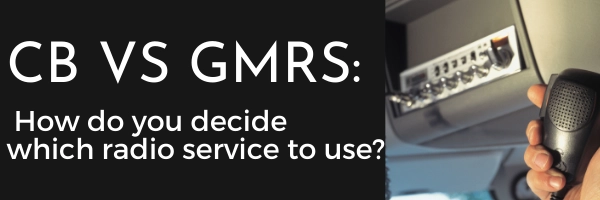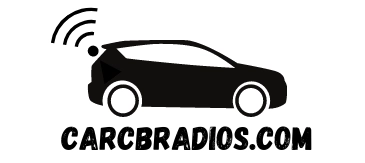By: Jeremy Neisser
When it comes to two-way radios, there are a lot of options available in the market. Two of the most popular types of radios are Citizen Band Radio (CB) and General Mobile Radio Service (GMRS). Both of these radios have their own unique features, advantages, and disadvantages.
In this article, I will provide you with a detailed comparison of CB radio vs GMRS radio so that you can make an informed decision about which one to choose.
CB Radio vs GMRS Radio
Ultimately, the choice between CB and GMRS radios depends on the user's specific needs and preferences. If range and sound quality are a priority, then GMRS radios may be the better choice. However, if simplicity and affordability are more important, then CB radios may be the way to go.

Understanding CB Radio & it's History
CB Radio was first introduced in the United States in the 1940s as a way for individuals to communicate with each other over short distances. The FCC allocated a specific set of frequencies for CB Radio use in 1958, and CB Radio became increasingly popular throughout the 1960s and 1970s.
CB radios are popular among truckers, off-roaders, and other outdoor enthusiasts. CB radios operate on a frequency range of 26.9650 MHz to 27.4050 MHz and are limited by law to a maximum power output of 4 watts. CB radios are easy to use, affordable, and have a range of up to 10 miles in ideal conditions. However, they are prone to interference and have limited privacy.
CB Radio, or Citizens' Band Radio, is a type of two-way radio that operates on a specific set of frequencies. CB Radio is popular among truckers, off-roaders, and other hobbyists who need to communicate over short distances.
In this section, I will provide an overview of CB Radio, including its history, technical aspects, benefits, and limitations.
Technical Aspects of CB Radio
CB Radio operates on 40 channels within the 27 MHz band. The maximum power output for CB Radio is 4 watts, and the maximum range is typically around 5 miles. CB Radio uses amplitude modulation (AM) to transmit and receive signals.
Benefits of CB Radio
One of the primary benefits of CB Radio is that it is relatively easy to use and does not require a license to operate. CB Radio is also relatively inexpensive compared to other types of two-way radios. Additionally, CB Radio is widely available and can be used in many different settings.
Limitations of CB Radio
One of the main limitations of CB Radio is its limited range. CB Radio is typically only effective over short distances, and its range can be further limited by factors such as terrain, weather, and interference from other devices. Additionally, CB Radio channels can become crowded, which can make it difficult to communicate effectively.
That's a brief overview of CB Radio, including its history, technical aspects, benefits, and limitations.

Understanding GMRS Radio & It's History
GMRS radios, on the other hand, operate on a frequency range of 462.5625 MHz to 467.7250 MHz and have a power output between 2 watts and a maximum of 50 watts. GMRS radios are more powerful than CB radios and have a range of up to 5 miles in urban areas and up to 25 miles in rural areas. They are more expensive than CB radios but offer better privacy and less interference.
Key Takeaways
- CB radios are limited to a maximum power output of 4 watts and have a range of up to 10 miles in ideal conditions.
- GMRS radios have a power output between 2 watts and a maximum of 50 watts and have a range of up to 5 miles in urban areas and up to 25 miles in rural areas.
- GMRS radios are more expensive than CB radios but offer better privacy and less interference.
History of GMRS Radio
GMRS (General Mobile Radio Service) is a licensed radio service that uses channels in the ultra-high frequency (UHF) band. It was established by the Federal Communications Commission (FCC) in the United States in the 1980s. Initially, it was intended for personal and business use, but it has since become popular for outdoor enthusiasts, such as hikers, campers, and hunters.
Technical Aspects of GMRS Radio
GMRS radios operate on frequencies between 462 and 467 MHz and can have a power output of up to 50 watts on certain channels. They use FM modulation and can transmit both voice and data. Unlike CB radios, GMRS radios require a license to operate, which can be obtained from the FCC. The license covers the use of GMRS radios by the licensee and their immediate family members.
Benefits of GMRS Radio
One of the biggest benefits of GMRS radio is its range. With the right equipment, GMRS radios can transmit over long distances, making them an excellent choice for outdoor activities. They also offer better sound quality than CB radios, thanks to their use of FM modulation. GMRS radios can also be used to communicate with other types of radios, such as FRS (Family Radio Service) and MURS (Multi-Use Radio Service) radios.
Limitations of GMRS Radio
One of the main limitations of GMRS radio is its licensing requirement. While obtaining a license is a straightforward process, it can be a barrier for some users who are looking for a simple and easy-to-use radio.
Another limitation is the cost of equipment. GMRS radios can be more expensive than CB radios, and the cost can increase significantly if you need to purchase additional equipment, such as external antennas or repeaters.
That's a brief overview of GMRS radio, including its history, technical aspects, benefits, and limitations.
CB Radio vs GMRS Radio: A Comparison
Range
When it comes to range, GMRS radios are generally considered to have better coverage than CB radios. GMRS radios can transmit up to 5 watts of power, while CB radios (both handheld radios and those found in vehicles) are limited to 4 watts. This extra wattage can make a significant difference in range, especially in areas with a lot of interference.
GMRS radios also have access to repeaters, which can extend their range even further. Repeater stations receive and re-transmit signals, effectively boosting the range of the radio. CB radios do not have access to repeaters, so their range is limited to line-of-sight.
Licensing Requirements
Both CB and GMRS radios require a license to operate legally. However, the licensing requirements for GMRS radios are more stringent. GMRS licenses are issued by the FCC and require a fee, while CB licenses do not require a fee. GMRS licenses also require a test, while CB licenses do not.
Equipment Cost
The cost of equipment for CB and GMRS radios can vary widely depending on the features and quality of the equipment. Generally speaking, CB radios tend to be less expensive than GMRS radios. A basic CB radio and antenna setup can be purchased for under $100, while a comparable GMRS radio setup can cost several hundred dollars.
Use Cases
CB radios are often used by truckers and off-road enthusiasts to communicate with each other while on the road or trail. They are also commonly used by emergency services and law enforcement agencies.
GMRS radios are often used by families and groups for outdoor activities such as camping, hiking, and hunting. They are also commonly used by businesses and organizations for communication between employees.
Overall, the choice between CB and GMRS radios depends on the specific needs and use cases of the individual or organization. CB radios are generally less expensive and easier to use, but have a more limited range. GMRS radios offer better range and more features, but require a license and can be more expensive.
Conclusion
In conclusion, both CB and GMRS radios have their advantages and disadvantages. CB radios are popular among off-roaders due to their simplicity and wide availability. They are also relatively inexpensive and do not require a license to operate. However, their range is limited, and the quality of the sound can be poor due to interference and static.
On the other hand, GMRS radios offer a wider range and better sound quality than CB radios. They also have more channels and can use privacy codes to mute squelch. However, they require a license to operate, and the equipment can be more expensive.
It is important to note that both CB and GMRS radios have their limitations and should not be relied upon as the sole means of communication in emergency situations. It is always a good idea to have multiple communication methods available, such as a satellite phone or a personal locator beacon, in case of an emergency.
Frequently Asked Questions
What is the difference between CB and GMRS radios?
CB (Citizens Band) radios operate on the 27 MHz frequency band and are limited to a maximum power output of 4 watts. GMRS (General Mobile Radio Service) radios operate on the UHF frequency band and can have a maximum power output of up to 50 watts. GMRS radios require an FCC license to operate, while CB radios do not.
Which has better range, CB or GMRS?
The range of a radio depends on many factors such as terrain, antenna height, and power output. In general, GMRS radios have a longer range than CB radios due to their higher power output and UHF frequency range. However, CB radios can still provide reliable communication over shorter distances.
Can a GMRS radio communicate with a CB radio?
No, GMRS radios and CB radios operate on different frequency bands and are not compatible with each other.
What are the advantages of using a GMRS radio?
GMRS radios have several advantages over CB radios. They offer higher power output, which can provide longer range communication. GMRS radios also have more channels available, allowing for more private communication. Additionally, GMRS radios can be used for both personal and business communication.
What are the advantages of using a CB radio?
CB radios are a popular choice for off-road enthusiasts and truck drivers due to their simplicity and ease of use. They are also relatively inexpensive compared to other types of radios. CB radios can provide reliable communication over shorter distances and are widely used in emergency situations.
Which is better for off-roading, CB or GMRS radio?
Both CB and GMRS radios have their advantages for off-roading. CB radios are widely used by off-road enthusiasts and truck drivers due to their simplicity and ease of use. GMRS radios offer higher power output and more channels, which can provide longer range and more private communication.
Ultimately, the choice between CB and GMRS radios depends on personal preference and specific communication needs.
You may like:

Hi & Welcome!
My name is Jeremy and I have been an avid car nut for many year. My first car was an 1987 Honda CRX. I put in my first Kenwood stereo, amp, 2 10" JLs and a CB Radio in it and have been an avid user of CBs and car radios for years. I'll do my best to share my tips, information and thoughts to help you with whatever question you might have, ABOUT ME
After I graduated from High School, I worked 5 years are Radio Shack and 3 years at Circuit City answering questions and helping customers with various electronics questions.

